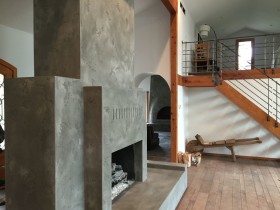

Yes, there will be rot behind a plaster coat made of lime in this situation, but the lime is not to blame, it is the combination of materials that were used. What is causing the rot is the overloading of moisture in the wall due to the uneven plaster moisture rates. I very often hear people complain about lime plaster being a bad choice because “they have heard” lime will cause rot in the bales. The remaining 2-3 units are stuck in the wall and will continue to build up in the straw, leading to moisture trapping issues which are the cause of bale decay. During that same hour, the lime will allow 7 or 8 units to exit the wall. In any given hour, the earthen plaster will allow 10 units of moisture to enter the wall. Let’s consider the most common application scenario: earthen on the interior and lime on the exterior. Those materials all have a different rate of permeation.

People decide to use earthen plaster on the home’s interior and lime (or even worse: cement) on the exterior. The second way that moisture gets trapped in a wall is something I see all the time.

DO NOT USE CEMENT BASED PLASTERS on a bale home. Sure they are stronger, but who cares when they will eventually cause your walls to rot. We know that cement based plasters don’t breathe well and we know they are more prone to cracking than lime or earthen plasters. For some reason, the use of cement in plaster is still celebrated by some builders. The first is to use a plaster than does not breathe well. There are two main ways to create this problem. This keeps the plasters well bonded and eliminates the high risks seen in the opposite application.įailure #2: Trapping moisture in the wall. By laying weaker plaster over a stronger finish coat, it will always be able to move at least as much as the coat beneath it. If the weaker plaster beneath a strong lime finish coat can move more than the finish coat, you will ultimately get delamination between the two coats which will lead to eventual plaster failure. This is important because plaster moves, as do homes. That makes the coats “weaker” as they move away from the wall. The second coat has more sand in it than the first coat and the third has more than the second. If you consider all plaster work over the last say…thousand years, one thing holds true no matter what material you use. The problem here is that what you have is stronger plaster over weaker plaster when in reality, you want it the other way around: weaker plaster over stronger plaster. People choosing to use earthen plaster for the scratch and brown coats and a final, “durability coat” of lime. This is perhaps the most common mistake that I see over and over again. If you avoid these two approaches to plastering your home, your plaster should provide you with a very long life.įailure #1: Mixing earthen and lime plasters on a wall surface. There are two common themes, or dare I say causes for the failures. A large percentage of the consulting work I do is helping clients deal with these plastering issues. That importance has not waned, and I am unfortunately hearing more and more stories about plaster failures around the world. Over the years I have spoken many times about the importance of a quality plastering job.


 0 kommentar(er)
0 kommentar(er)
